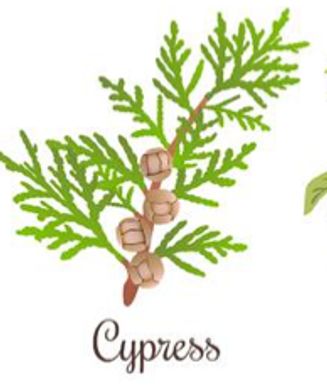Essential oils have been used for ...
thousands of years.
Psalm 45:7-8, Proverbs 27:9, Isaiah 61:3, and Hebrews 1:9 all reference oils in some way...
as in “the oil of joy” and “the oil of gladness,”
and they speak of how oils “rejoice the heart.”
Frankincense
Frankincense
Frankincense

Frankincense is the king of the oils.
used in incense and perfumes.
The word is from Old French franc encens, meaning "True Incense"
It was a primary component of holy incense, medicine, and currency.
The use of Boswellia resin for spiritual and medicinal purposes dates back to ancient civilizations.
Effective in conditions like asthma, rheumatoid arthritis, inflammatory bowel diseases, osteoarthritis, and relapsing-remitting multiple sclerosis.
This essential oil has antimicrobial activities & exhibits neuroprotective activity.
Abrahamic religions use it to cleanse the house of evil energy.
Myrrh
Frankincense
Frankincense

Used as an ointment, an incense, an embalming ingredient and as a skin beauty treatment. It's most common usage was holy anointing oil.
Myrrh resin has been used throughout history as a perfume, incense and medicine.
Exodus 30:23–25 specifies that Moses was to use 500 shekels of liquid myrrh as a core ingredient of the sacred anointing oil.
Myrrh is also listed as an ingredient in the holy anointing oil used to anoint the tabernacle, high priests and kings.
Cinnamon
Frankincense
Cedarwood

Used to cleanse the air, kill mold and act as natural medicine.
In Proverbs 7:17, Solomon uses this aromatic oil in the bedroom and as a natural perfume or cologne.
Cinnamon was so highly prized among ancient nations that it was regarded as a gift fit for monarchs and even for a deity.
Its source was kept a trade secret in the Mediterranean world for centuries by those in the spice trade, in order to protect their monopoly as suppliers.
In Ancient Egypt, cinnamon was used to embalm mummies.
Cedarwood
Cedarwood
Cedarwood

King Solomon used cedarwood in building God’s temple and Jesus was crucified on a cross made of cedarwood or cypress.
It was thought to bring wisdom.
It was used for ritual cleansing, and served as medicine in treating skin conditions and leprosy.
The cedar and ezob have more practical applications, with cedarwood having medicinal properties, and ezob being a good implement.
SPIKENARD
Cedarwood
SPIKENARD

Spikenard was used as perfume and healing ointment. Interestingly, the “spikenard” used in the Bible was lavender oil.
Spikenard is a class of aromatic amber-colored essential oil derived from Nardostachys jatamansi, a flowering plant in the honeysuckle family which grows in the Himalayas of Nepal, China, and India.
Used for centuries as a perfume, a traditional medicine, or in religious ceremonies.
The Vatican said the coat of arms of Pope Francis includes spikenard .
HYSSOP
Cedarwood
SPIKENARD

Hyssop appears at Jesus’ crucifixion.
Hyssop has been used for centuries in traditional medicine to increase circulation and to treat multiple conditions such as coughing and sore throat. Hyssop can stimulate the gastrointestinal system and is a soothing expectorant.
Hyssop was revered for its cleansing effect in connection with plague, leprosy and chest ailments and symbolically in cleansing the soul.
CASSIA
SANDALWOOD
SANDALWOOD

Cassia was a highly valued commodity.
Keziah, the name of Job's daughter in the Old Testament, derives from the name of the plant as well.
Cassia has ties to the Ancient Roman name Cassius, an Ancient Roman family name meaning "hollow."
Cassia is one of the rare names that's truly unusual yet has a stylish feel.
SANDALWOOD
SANDALWOOD
SANDALWOOD

Sandalwood is referred to as “aloes” and is called one of the oils of joy and gladness.
Nicodemus and Joseph of Arimathea brought sandalwood (aloes) and myrrh to bury Jesus, and in today's market, the amount of oils used would be worth an estimated $200,000
CYPRESS
SANDALWOOD
Galbanum

Cypress is celebrated as a symbol of strength, security and prosperity.
In Genesis 6:14, God commanded Noah to “make yourself an ark of gopher wood,” which in modern English is in fact “cypress.”
Symbol for sacrifice, death, and mourning.
Galbanum
ROSE OF SHARON
Galbanum

Galbanum is a main ingredient of the holy incense used in the heart of the temple.
When burned with other sweet smelling oils in holy incense, it has the most beautiful scent and was thought to balance the emotions.
ROSE OF SHARON
ROSE OF SHARON
ROSE OF SHARON

Mentioned in the Song of Solomon, the rose of Sharon is similar to the hibiscus or tulip.
The deciduous flowering shrub known as the rose of Sharon is a member of the mallow family which is distinct from the family Rosaceae.
CALAMUS
ROSE OF SHARON
ROSE OF SHARON

Calamus is an ancient herb that we now know as lemongrass.
Calamus was used in perfumes, incense and as an ingredient in the special holy anointing oil used by the priests in the temple.
Copyright © 2022 Herameah LLC - All Rights Reserved
